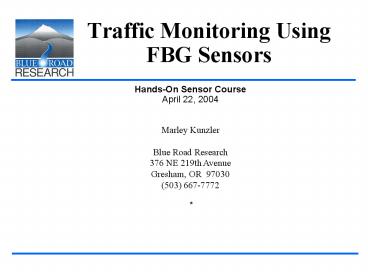Traffic Monitoring Using FBG Sensors - PowerPoint PPT Presentation
1 / 41
Title:
Traffic Monitoring Using FBG Sensors
Description:
Functionality of the Dynamic FBG System ... 207th Overpass. On Ramp. j. k. m. l. n. Sensors are approx. 7 feet apart in left wheel lane. ... – PowerPoint PPT presentation
Number of Views:929
Avg rating:3.0/5.0
Title: Traffic Monitoring Using FBG Sensors
1
Traffic Monitoring Using FBG Sensors
Hands-On Sensor Course April 22, 2004 Marley
Kunzler Blue Road Research 376 NE 219th
Avenue Gresham, OR 97030 (503) 667-7772
2
Outline
- 1. Functionality of the Dynamic FBG System
- 2. Background on Project
- 3. Results from Testing
- 4. Summary Future Work
3
Functionality of the Dynamic FBG System
Light is launched through the core of a fiber
optical strand to the grating
4
Functionality of the Dynamic FBG System
As the fiber undergoes tension compression, the
grating spacing changes
5
Functionality of the Dynamic FBG System
The gratings reflection is spectrally demodulated
6
1998 - Horsetail Falls CFRP Strengthening
7
FBG Traffic Sensor Advantages
8
Overview Leading up to First Freeway Install
- In July, 1999 Oregon Dept. of Transportation
contracted Blue Road Research to develop a
traffic sensor (based on fiber optic sensor
technology) which is more durable, reliable and
cost\installation effective than traditional
sensing methods. - The primary focus of the contract a sensor for
vehicle classification and counting, (flexibility
for other traffic sensing applications). - After preliminary testing on a concrete and
asphalt testpad, sensors were installed in the
Interstate 84 freeway East of Portland, Oregon on
August 1, 2001.
9
Blue Road Research Goals
- Create and Demonstrate a Fiber Optic Traffic
Sensing System - Count and Classify Traffic Using Fiber Optic
System - Test Ruggedness of Sensors for Freeway Use
- Determine Optimal Installation Procedures
- Develop an Enhanced Traffic Sensor Product Line
10
Final Layout (Top-View)
11
Final Layout (Sensors Area)
Junction Box
Fiber Backbone Line
Bicycle path
On Ramp
207th Overpass
Sensors are approx. 7 feet apart in left wheel
lane.
n
l
k
m
j
Sensor 5 (diagonal) monitors temperature.
12
Grooving 205th Avenue to Enable Fiber Optic
Installation Remote Monitoring
13
Trenching the Fiber Optic Cableto the Freeway
Site
14
Cutting Grooves for Sensor Placement in the
Freeway Lanes
15
Installation of the Traffic SensorsInto Portland
Cement Concrete
16
Filling the Sensor Grooves with Bituminous Hot
Melt (375 F)
17
Roadside Junction Box at Ground Level
18
Installation of the Traffic System Network
19
Data Collected from Semi Trailer
20
Data Collected from Semi Trailer
Relative Amplitude vs. Time
21
Car Profile
22
Conclusions Future Work
- Costs prohibitive for traffic classifier, but not
Weigh-in-Motion (WIM) - Development under NSF of up to 12 channel
self-tuning readout system suitable for freeway - Pursuing funding for WIM research
23
Modal Analysis of Bridges Using Fiber Bragg
Grating Sensors
- Background
- Long gage length fiber Bragg grating sensors
- Modal Analysis
- Full scale field test, 2002
- Current work
- Blue Road Research multiplexed FBG system
- Laboratory Experiments
- Fairview Model Bridge
- Broadway Bridge work
- Summary
Session 6, Page 64
24
Acknowledgements
- National Science Foundation
- STTR Grant No. DMI-0131967
- Caltrans
- Support of full scale field test
- Oregon DOT
- Continuing support of civil structures research
ODOT
- Multnomah County Bridge Section
- Support of upcoming bridge system deployment
Session 6, Page 65
25
Long Gage Length Fiber Bragg Grating Sensors
Packaging
Aluminum bulkheads for anchor points
Rugged housing
- One meter gage length
Session 6, Page 66
26
Modal Analysis (1 Degree of Freedom)
Session 6, Page 67
27
Modal Analysis (1 Degree of Freedom)
Tongue, Benson H. Principles of Vibration. Oxford
University Press Oxford. 1996. 101.
Session 6, Page 68
28
Modal Analysis (multi-DoF)
Session 6, Page 69
29
Modal Analysis (multi-DoF)
Session 6, Page 70
30
Experimental Validation of the Approach 2002
Carbon Splice Test
- 30 composite wrapped concrete beam with splice
at midspan - Test performed by UCSD, FHWA, CALTRANS
- Blue Road Research and UCSD
- Placed optical sensors on the beam
- Performed dynamic tests
Session 6, Page 71
31
Carbon Splice Test I-5 Gilman Bridge
Session 6, Page 72
32
Carbon Splice Test Mode Shapes
Session 6, Page 73
33
Carbon Splice Test Modal Vectors
Session 6, Page 74
34
Conclusions from Splice Test
- Strong agreement between accelerometer and FOS
data - Validates use of Long Gage FOS in system
identification - Clear changes in modal characteristics with
damage - Suggests that this method will work for detecting
structural damage in bridges
Session 6, Page 75
35
Current Work
- Algorithm refinement by UCSD
- Enable location and quantification of damage
through system identification - Hardware development for sensor data acquisition
- Acquire data from eight sensors simultaneously
with sub-microstrain resolution - Full scale deployment on the Broadway Bridge in
Portland, Oregon - in planning with Multnomah County Bridge Section
Session 6, Page 76
36
Laboratory Tests Instrumented I-Beam
Session 6, Page 77
37
Laboratory Tests Parked and Sweeping Etalon
Parked
Sweeping
Session 6, Page 78
38
Laboratory Tests Parked Etalon
Session 6, Page 79
39
Field Tests BRR Fairview Bridge
- Environmental Effects
- Temperature
- Wind
- Performance
- Modal Analysis with controlled damage
- Quasi-static loading
- 20x4 steel truss
- Concrete and composite deck
- Sensors installed in concrete
- Sensors planned for installation on structure and
in composite section
Session 6, Page 80
40
Blue Road Research Health Monitoring and Seismic
Damage Assessment System
Session 6, Page 81
41
Cable Routing from Readout Unit to Sensors
Session 6, Page 82































